Star Wars Starship/Vehicle Discussion Thread
-
For the very 1st discourse, I felt it only fitting that we talk about the most well known starfighter ever in the SW Universe. The one machine which played a hand in the slaying of both Death Stars, and piloted by arguably the most celebrated fighter squadron of the Rebellion and New Republic, Rouge Squadron.
I present, the venerable Incom Corporation T-65 X-Wing Space Superiority Starfighter!
Armed with 4 laser cannons and 2 proton torpedo tubes with a rack of 3 torpedos each, the Sleek, swift, and deadly 100MGLT X-Wings is the backbone of the Rebel Alliance and later, New Republic Starfighter Command.
Pressed into service time and again, the typical Alliance X-wing shows the scars from previous engagements, though the fact that it still performs as an advanced vessel of space superiority is indication of the ruggedness of the craft.
The sleek fuselage of the X-wing starfighter is 12.5 meters long. The long, narrow spaceframe is flanked in the aft quarter by four massive realspace engines. Each engine has an aerodynamic S-foil mounted on it. The wings not only serve as stabilizer surfaces in air travel, but also distribute deflector shield energy and serve as weapons mounts. The surface of each S-foil bears squadron and fighter markings.
Located midway through the ship is the X-wing's cockpit module. Behind the X-wing's cockpit is an astromech socket. The astromech droid provides astrogation data for the fighter's hyperdrives, and serves as a co-pilot and technician during flight. Three landing gears extend when the fighter is docked.
-
The X-wing starfighter became the premiere Alliance weapon when the Empire nationalized the Incom Corporation. Technicians and suppliers in the employ of Incom were secretly sympathetic to the Alliance, and during a daring Rebel raid, they defected to the Rebellion, bringing the X-wing fighter prototypes with them. Like its predecessor, the Incom/Subpro Z-95, the X-wing fighter has a reputation for being able to absorb damage, but is also quite fast and maneuverable. In response to the X-wing fighter threat, the Empire designed the new TIE interceptor to be its space superiority fighter. The X-wing would become the mainstay fighter for the Alliance for much of the Galactic Civil War.
The X-wing fighter has a compact life support system of compressors, temperature regulators, and oxygen scrubbing filters. A series of acceleration compensators help isolate the pilot from deadly g-forces generated by high speed maneuvers. There is enough oxygen, fuel and power in an X-wing for a week of non-combat operations. Additional consumable tanks can be affixed to the S-foils at a cost of performance.
Behind the cockpit, accessible from both behind the pilot's chair and a belly hatch, is the cargo compartment. It has a capacity of two cubic meters, and is rated for 110 kilograms. Pilots generally store survival and repair gear in this compartment. The newer T-65AC4 can carry 150 kilograms of cargo.
In emergencies, the X-wing's Guidenhauser ejection seat can throw the pilot clear of the fighter. Separator charges blast the cockpit canopy free, and also launch the astromech unit from the socket.
A fully integrated Torplex Rq8.Y flight computer translates flight data from control surfaces to engine performance. Like most starfighters, X-wings don't come equipped with slave circuits. Power for the X-wing is generated by a centrifugal vapor fusion and ionization reactor housed behind the astromech socket. The generator's initial spins are powered by Novaldex O4-Z cryogenic cells housed in the ship's aft engineering section. These power cells are recharged through a super-conducting port. Once powered, the four Incom 4L4 fusial thrust engines propel the starfighter. Some models were equipped with Incom 4j.4 engines rated at 300 KTU. The newer T-65AC4 can attain an impressive sublight speed comparable to the Alliance A-wing. Maneuverability is afforded by a system of etheric rudders that change thrust vectors.
In an atmosphere, the X-wing's Incom RDA repulsorlift drive adaptor provides an airspeed of 1,050 kilometers per hour. The fighter handles nearly identical to a T-16 skyhopper in an atmosphere. The New Republic-era fighter can attain speeds of at least 1,300 kilometers per hour.
For hyperspace transit, the X-wing is equipped with an Incom GBk-585 motivator HCU (hyperspace control unit). The motivators on each engine provide a class one performance.
The X-wing's main fuselage houses most of its essential electronic components. The nosecone contains the primary sensor array, consisting of a Fabritech ANs-5d "lock track" full-spectrum transceiver, a Melihat "Multi-imager" dedicated energy receptor and a Tana Ire electrophoto receptor. An alternate configuration typically contained a long range Phased Tachyon Detection Array model #PA-9r, and a short range Primary Threat Analysis Grid model #PG-7u. The array feeds information through a shielded multiplexer relay to the ANq 3.6 sensor computer. The unit can track up to 1,000 moving sublight objects, acquire 20 possible targets, and can be programmed for extra sensitivity to 120 specific sensor signatures. At the very rear of the craft is a Fabritech k-blakan mini sensor providing the pilot a view of the ship's rear arc. One of the X-wing's primary weaknesses is a blind spot at the rear of its belly.
A Bertriak "Screamer" active jammer is the standard sensor jammer employed by X-wing fighters. The Screamer isn't powerful enough to jam capital-scale sensor systems, but it can interfere with homing warheads and jam starfighter sensors.
Four identical Taim & Bak KX9 laser cannons are mounted on each S-foil wingtip. During combat situations, the S-foils split into attack position, deploying in an "X" configuration. This increases the fighter's field of fire, and ensures that all lasers target in to a specific "zero" point, typically half a kilometer from the fighter. The lasers are powered by the engine power converters and are fed by dynoric energy lines that run the surface of the S-foils. A number of X-wings used Taim & Bak IX4 laser cannons instead. The New Republic era fighters employ even more powerful cannons. The laser cannon efficiency is one of the hallmarks of the X-wing starfighter. At full recharge, this allows for continuous fire.
For long range targeting, the fighter has two Krupx MG7 proton torpedo launchers housed in the main fuselage. Each launcher fires from a three-torpedo magazine for a total payload of six warheads. For added accuracy in bombing runs, a targeting computer screen mask extends on a mechanical arm to assist the pilot with precise firing data. The refitted X-wing recon fighters have had the proton torpedo launcher removed and replaced with high-gain long range sensors, processors and high-speed hypertransceivers.
Some X-wings were equipped with decoy and carbon-fiber chaff mines that could be fired in dogfight situations. The decoys would broadcast a sensor signature similar to the X-wing, confusing enemy scanners. The carbon-fiber chaff mines would create dangerous clouds of sensor-opaque debris that could damage pursuing vehicles or prematurely detonate incoming warheads.
The X-wing's deflector shield generator is in the aft section of the vessel. It produces basic shield matrices through a catalyzation process, and then feeds deflector ducts scattered along the fighter's surface. The Chepat "Defender" projectors along the S-foil surfaces generate the starboard and port shields. This supplements the hardened titanium armor alloy of the X-wing. The expensive and high-strength alloy sedrellium is used to reinforce the X-wing's hull.
courtesy of www.starwars.com databank -
Throughout the Galactic Civil War, the Alliance always had precious few X-wing fighters compared to the Empire's seemingly endless arsenal of TIE craft. As a result, the Alliance X-wings were often in a state of constant use. A "new" X-wing is a rare sight, as the starfighters showed the wear and tear that their pilots would subject them to. Common models of fighters in the Galactic Civil War included the T-65B and the T-65C-A2.
The heroic Red Squadron that succeeded in destroying the Death Star at the Battle of Yavin was composed of X-wing fighters. The survivors of this squadron where organized by Commander Narra and Lt. Commander Luke Skywalker into the nascent Rogue Group. Under the command of Wedge Antilles, Rogue Squadron emerged as the premiere X-wing starfighter force in the galaxy.
At the Battle of Endor, Wedge had the option to outfit his squadron with newer fighters like the A-wing or B-wing. Instead, he opted to go with the venerable X-wing fighter. During that fateful battle, Rogue Squadron flew as Red Group, to honor the pilots of the first Death Star battle.
Rogue Squadron soon became a symbol of the Alliance itself, and the New Republic that would follow. It played key roles in battles over Bakura, Borleias, Coruscant and Thyferra. Older cruiser captains often resented the glamour afforded to the X-wing pilots, and nicknamed them "X-wing hotshots."
Later, with the introduction of new fighters like the A-9 Vigilance Interceptor and the E-wing fighter, the X-wing was pushed from the limelight. Eventually, after years of research and modification, Incom unveiled a new faster Incom T-65AC4 fighter that can compete on its own in the modern starfighter combat arena. The older X-wings are being refitted into T-65BRs, or reconnaissance X-wings.
The recon fighters have their missile weapons replaced with advanced sensors and communication gear. In addition, these X-wings are equipped with sophisticated self-destruct sequence that wipes the ship's computer, destroys the astromech with a shaped charge, kills the pilot with a lethal injection and then finally detonates a baradium charge that not only destroys the X-wing, but is powerful enough to cripple a nearby ship.
Thirteen years into the New Republic's rule, Incom introduced the T-65D-A1 X-wing starfighter, which featured notable changes. To standardized performance in the New Republic forces, General Wedge Antilles ordered that all older model X-wings be updated to conform to the new specs. The new model featured an advanced computer system that integrated all the functions of the supplemental astromech droid into one package. As such, the T-65D-A1 needed no astromech socket, and did not sport one. The new X-wing's advanced computer system was accessible from the cockpit, allowing the pilot more customizable options during flight and combat.
The introduction of the T-65D-A1, unfortunately, was exploited by would-be terrorists. Each new computer system retrofitted into an older X-wing, or that came standard with a newer model, was equipped with a hidden explosive detonator. This insidious sabotage was set to go off when a specific combination of computer commands was executed. This act grounded the New Republic X-wing arsenal for a time, and seriously hampered the success of the T-65D-A1 refit.
In an effort to stave away obsolescence, Incom continually revisits and updates the X-wing design. The latest incarnation is the XJ X-wing. Sporting a trio of proton torpedo launchers, improved speed, armor and maneuverability, the XJ model is a cutting edge design that is still faithful to the classic T-65 that inspired it. It is a common vessel found in the ranks of the new Jedi Order.
courtesy of www.starwars.com databank -
A Comparism of Galatic Republic and Seperatist Capital Ships
Galatic Republic Forces:
Venator-Class Cruiser
Lenght:
1,137 meters long
Manufacturer:
Kuat Drive Yards
Type:
Cruiser (Venator-class Star Destroyer)
Weapon:
8 heavy turbolasers; 2 medium dual turbolasers; 52 laser cannons; 4 proton torpedo launchers; 6 tractor beam projectors
Acclamator-class Assault Ships
Lenght:
752 meters long
Manufacturer:
Rothana Heavy Engineering
Type:
Acclamator-class trans-galactic military transport ship
Weapon:
12 quad turbolaser turrets, 24 laser cannons, 4 missile/torpedo tubes
Surprisingly, 3 common ships in the days of the Old Republic were not seen. Victory-Class Star Destroyers, Bulk Cruiser and Dreadnaught Heavy Cruiser
Victory-Class Star Destroyer
Length:
900 meters long
Manufacturer:
Rendili StarDrive
Type:
Destroyer (Victory-class Star Destroyer)
Weapon:
10 quad turbolaser turrets, 40 double turbolaser turrets, 2 missile/torpedo tubes 10 tractor beam projectors
Bulk Cruiser
Length:
600 meters long
Manufacturer:
Rendili StarDrive
Type:
Modified Bulk Cruiser
Weapon:
30 quad laser cannons, 2 forward tractor beam projectors
Dreadnaught Heavy Cruiser
Length:
600 meters long
Manufacturer:
Rendili StarDrive
Type:
Dreadnaught heavy cruiser
Weapon:
10 turbolaser cannons, 20 quad turbolaser cannons, 10 turbolaser batteries
-
woah heng,too long leh...gong liao...

-
I also blur liao...too much inside infoOriginally posted by Takumi2eLimit:woah heng,too long leh...gong liao...


-
Well I want more info, best if there's info on A-Wings, B-Wings, Y-Wings, Snowspeeder.
The Imperial TIE Fighters, TIE Interceptot, TIE Bomber, TIE Advanced... -
coming coming.Originally posted by kopiosatu:Well I want more info, best if there's info on A-Wings, B-Wings, Y-Wings, Snowspeeder.
The Imperial TIE Fighters, TIE Interceptot, TIE Bomber, TIE Advanced...
there are a lot of TIE variets and models did u know?
-
I know TIE fighters take 2 shots to take down.Originally posted by HENG@:coming coming.
there are a lot of TIE variets and models did u know?
TIE interceptors 4
TIE Bombers around 8
TIE Advanced have deflector shields...
Then one more level is supposed to be a secret project. -


damn shiok to destroy inside comp game.. -
I think that's the AT-ST Walker.Originally posted by SMAPLionHeart:how about the chicken walker? i love it
The bigger version is the AT-AT Walker. -
AT-AT walker need to use a rope and bind it legs to destroy it right?Originally posted by kopiosatu:I think that's the AT-ST Walker.
The bigger version is the AT-AT Walker.
i played that game b4 =) -
Tie Defender? as well as that, there are more tie varients.Originally posted by kopiosatu:I know TIE fighters take 2 shots to take down.
TIE interceptors 4
TIE Bombers around 8
TIE Advanced have deflector shields...
Then one more level is supposed to be a secret project. -
Then POST LEH~!!!!Originally posted by HENG@:Tie Defender? as well as that, there are more tie varients. -
okok. heres a list of all TIE varientsOriginally posted by kopiosatu:Then POST LEH~!!!!
Fighter [Old Republic era]
Fighter [white]
Fighter [grey] aka Tie/ln
Fighter [extended]
Vanguard
Scout
Boat
Bomber
Boarding Craft
Shuttle
[Giel's transport]
Lander
Transport
Interceptor
[assault TIE]
[X1]
[X1 relative]
Avenger
Defender
Scimitar
Drone
Phantom
[V38]
Raptor
"TIE crawler"
"tri-fighters"
"uglies"
Sith Infiltrator
[X-Wing: Alliance vessels]
heres a frontal silhouette view of some of these TIEs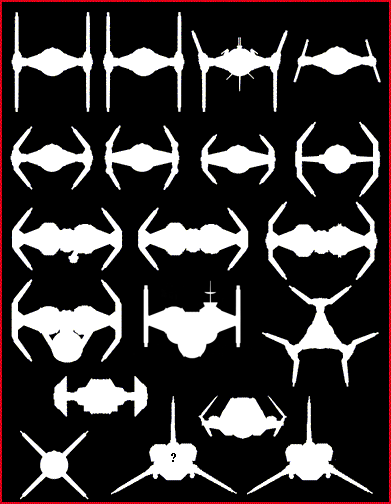
-
TIE White
These classic TIE fighters predate the completion of the first Death Star, but it isn't yet clear whether the same model was used during the time of the Old Republic. The linear acceleration of these ships was on par with rebel X-Wing starfighters: both are rated at 100MGLT in the performance diagram drawn by ILM artists. Except for Lord Vader's craft, all of the Imperial fighters deployed at the Battle of Yavin was of this kind.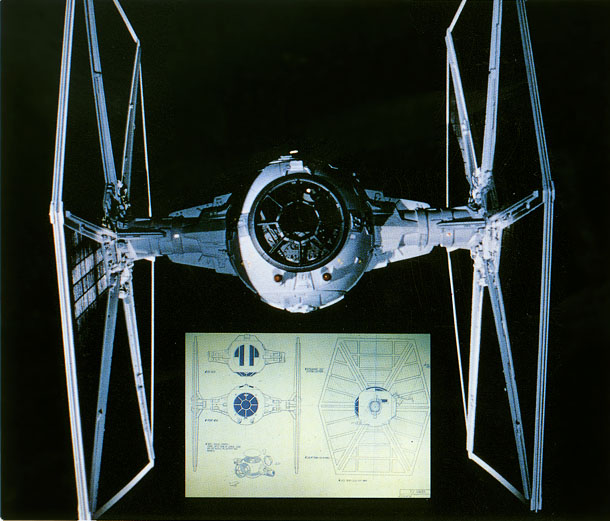
TIE Dark(Tie/ln)
The new standard TIE/ln fighter is visually distinguished from its basic TIE predecessor by the darker hue of its primary hull alloys. Faster and more durable, it still lacks hyperspace capabilities, but may be capable of more extended sublight flight, such as the pursuit of the Millennium Falcon from Hoth. The manufacture of a single TIE/ln is supposed to cost 60000 credits.
There exist several specialised variants of this TIE. Most of them have been described adequately elsewhere; their differences are not great enough to warrant separate treatment here. The TIE/rc is a short-range reconnaissance craft. TIE/gt is a light ground-support bomber. TIE/fc fighters provide target designation and telemetry data to aid the fire-control of long-range strikes by warships or baseline combat fighters.
TIE Fighter [extended]
TIE fighters with extended aft sections were part of Admiral Griff's forces based at Jovan station and participating in the early strikes against the rebels' base at Yavin IV. This tail section resembles the structure of the Kenner TIE Fighter toy. Its function is unknown, but it is reminiscent of Lord Vader's fighter, and therefore it may contain shields or a hyperdrive unit.
It seems to be a commonplace vessel, at least in the campaign against the Yavin rebels. The fighter was not unique to Admiral Griff's command either, because at least one more example appears in Moff Tavira's forces about a year after the Battle of Endor, in X-Wing Rogue Squadron: The Warrior Princess. -
TIE Vanguard
This is a short-range reconnaissance TIE based on the common TIE fighter. However the physical difference between the TIE Vanguard and TIE Fighter are greater than for the TIE/rc reconnaissance craft. Several large antennae for sensors and scanners protrude from the cockpit ball. The upper section of each wing is shortened and swept outwards to reduce interference with some of the dorsal scanner devices. In extrinsic terms, this vessel was invented for the SWCCG card game; in intrinsic terms, it was deployed by Imperial forces at least as early as the Battle of Yavin.
TIE Scout
A hyperdrive-capable scout and reconnaissance craft, sometimes designated the Sienar Ships "Lone Scout-A". The unipod hull appears to be much longer and thicker than that of the smaller TIE fighters, but the front end is the same standard ball cockpit. There usually is a single laser cannon on the chin of the cockpit ball, although limited-production double-cannon variants have been seen.
In order to support the large radiator wings, the wing pylons are the thicker, sturdier kind, similar to those of Lord Vader's long-range fighter. The wings are bent, but unlike the wings of a bomber or boarding craft, there is only one bending edge.
The wing area is mostly above the midplane of the ship; presumably this is to keep the wings clear of the ground during independent planetary landings. As a scout craft, this ship should be able to land in places other than the conventional ceiling rack of a garrison base or warship. The TIE Scout probably has retractable landing pads like the larger TIE transports.
TIE Boat
The STAR WARS Encyclopedia mentions the existence of a "TIE Boat" in the general section on "TIE fighters." This name alone doesn't say anything clear about the nature of the TIE Boat. It may be a "boat" in the sense of being a transport capable of carrying several people on modest journeys (in the same maritime/space analogy as "star pilots", "star destroyers" and "star freighters"). In this case the TIE Boat might be something like Giel's transport or the landing craft described below. Alternatively it might be a description of a TIE vessel designed for aquatic landings or aquatic travel.
The roleplaying adventure Battle for the Golden Sun describes a model of TIE Fighter Boat. This may be the TIE Boat mentioned in the SW Encyclopedia. According to the notes, "these particular TIEs have been designed exclusively to operate underwater." Does this mean that they can only operate underwater, or does it mean that they result from an exclusive design process? No physical description is given, so it is not yet known how greatly these ships differ from TIE starfighters. Radiator wings would hamper the craft with enormous drag underwater, and the cooling contact with water might reduce the need for radiators. Though TIEs are known to operate in atmosphere, it would require a remarkable ion engine to expel its particle stream through a medium as dense as seawater. There may be a different kind of supplemental propulsion system. -
TIE Bomber
This twin-hulled short-range TIE is the Empire's most common dedicated bomber. Slow and unmanoeuverable compared to TIE fighter craft. The starboard pod contains the one-man cockpit; the portside pod is dedicated to the payload and associated launch systems. Depending on the mission objectives, TIE bombers are loaded with various yields of missile weapons, passive inertial bombs or mines The EGVV schematics indicate that the engines are in the thick brace between the hull pods, though the positions of the nozzles aren't shown.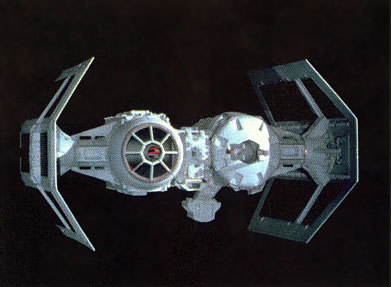
TIE Boarding Craft
TIE Boarding Craft were conceived for A New Hope but could not be included in the film. These bent-wing vessels are one of the oldest common TIE models, dating back to the earliest days of the Palpatine's rule. It seems that the star destroyer Imperator was designed to carry six of these ships [according to the Star Destroyer Imperator Class blueprints]. TIE Boarding Craft were also a major part of the hangar complement of the Death Star battle station (806 were carried).
The wings and hull design are similar to those of a TIE Bomber or TIE Shuttle, but the vertical segment is somewhat larger, and appears to have radiator panels on its inner surface as well. Considering the similarity of hulls, the engines are probably arrayed in the same way as those of a TIE Bomber. The starboard pod contains the cockpit, but has space for more occupants. The portside pod carries at least a squad of stormtroopers for boarding operations. The forward end of the port pod bears what looks like a docking clamp, and presumably has a general-purpose airlock and automatic cutting torches to breach the enemy ship or space station. It is possible that this mechanism may be extensible beyond the vessel's wings to facilitate mating with a wider variety of docking ports.
TIE Shuttle
This design was brought out of obscurity in The Empire Strikes Back, when Captain Needa used one of these TIEs as a courier and shuttle craft to report to Lord Vader. Whether the shuttle and the boarding craft are the same is unclear; they have similar shape and size. The boarding craft certainly must have superior armour and speed, since it is principally used during hostilities. The interior of the TIE Shuttle is less cramped, giving the courier passengers more space than the more numerous stormtroopers who are carried in each TIE Boarding Craft. Considering the similarity of hulls, the engines are probably arrayed in the same way as those of a TIE Bomber.
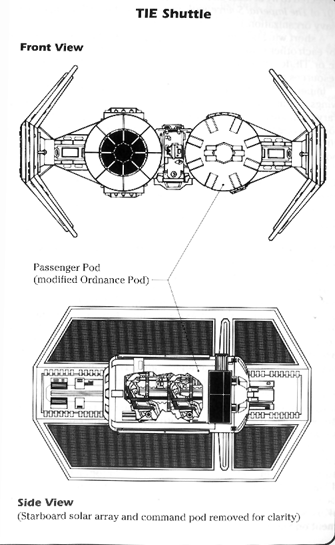
-
TIE [Giel's transport]
This bent-wing TIE transport craft is based around a single heavy hull pod. Like the flat-wing triple-hulled TIE transport described elsewhere, the lower wing surfaces are short enough so that they do not touch the ground; support is provided by two pairs of landing gear. Present imagery does not make the engines obvious, but circumstantial evidence indicates that it has a hyperdrive.
On the dorsal surface there are two large antenna arrays for communications or scanning. The craft appears to be capable of transceiving interstellar hyperwave channels with a sufficiently powerful warship like the Executor, although the TIE is probably not able to open a channel alone (much the same as for the hyperwave equipment on other small starships, probots and tracking devices).
This vessel has a single pilot (who wears an open "cockroach" helmet rather than combat flightsuit) and room for at least one passenger. Considering its use by former-Admiral Giel in his investigation of the abandoned rebel base at Golrath, it was probably able to carry at least a squad of stormtroopers as well.
TIE Transport/Lander
At least two distinct models of large, triple-hulled vessels are designed to carry large numbers of troops or other personnel. They are used as dropships or as regular troop shuttles. As a planetary landing craft, these TIEs carry no less than eleven troops, and they seem to have space for many more: perhaps a whole platoon. Seen in the Marvel comic series.
Two different models are known, distinguished by their wing details and the functions and features of the three hull modules. (It would be fairer to treat each design in a separate section; a future revision of this document will do so.) There is a flat-wing design with smaller radiator area, and a bent-wing model with somewhat larger area. The bent-wing model was in use at least ten years prior to the Battle of Hoth; the flat-wing model was employed on Imperial-occupied Bespin before Palpatine's fall.
On the bent-wing landing craft model, the cockpit is in the starboard upper hull module. The forward end of the lower module has a hatch for debarking troops. The front of the upper portside module has a mechanism resembling that of the equivalent section of a TIE Boarding Craft or TIE Bomber.
In the flat-wing transport ship the cockpit is in the lower module. On the front of each of the upper modules there is what appears to be a large boarding hatch for troops and their equipment. The stern is massive and structurally complex, and it extends well behind the wings. A pair of circular structures on either side of the tail resemble standard airlock docking rings. However they may be too close to the engines to perform that kind of function.
Unlike most military TIE designs, these ships have sets of landing gear. The wings may be unable to bear the ship's weight, so they are positioned high enough so that they never touch the ground. The flat-wing model has its flat wings positioned somewhat higher.
-
TIE Interceptor
This short-range fighter was first manufactured soon after the Battle of Yavin, and became abundant by the time of the Emperor's fall. One of the faster Imperial starfighters; its acceleration rating is 125MLGT according to ILM concept diagrams prepared during the production of Return of the Jedi.
The interceptor has numerous hard points for laser cannons. The most basic model has four cannons, which can be quad-linked, on the front tips of the wings. The sub-class of interceptors deployed at Endor bore a pair of identical cannons in the usual place below the forward window, and two more pairs on the hub of each wing near the targeting sensors. This gives a blistering firepower with a total of ten laser cannons. Of course, it is possible that some of the extra weapons are ion cannons or other types of armament, but their visible structural details are identical to the conventional laser cannons.
It is unknown whether there are any practical disadvantages counterbalancing the benefits of the weapons upgrade. Perhaps the heavily armed interceptors have marginally greater energy consumption, and therefore need to return to base for refueling slightly sooner than the basic model. Perhaps they simply are more expensive to construct and more difficult to maintain.
Other variants included a hyperspace-capable version (possibly a separate class rather than a retrofit) employed by Admiral Trigit in the forces of Warlord Zsinj [X-Wing Wraith Squadron]. When Grand Admiral Thrawn returned from Unknown Regions to confront the New Republic, he ordered the development and installation of potent deflector shields on his forces' TIE Interceptors.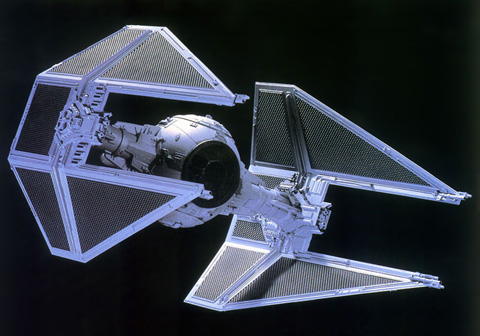
[assault TIE]
Another distinct fighter, with greatly enhanced and overpowered weaponry, was used at least as early as a few months after the Battle of Endor. This ship had four cannons of enormous size on the wingtips, and one cannon of more ordinary magnitude on each wing hub. There are no weapons on the chin of the cockpit ball.
The observed example was flown by one Major Grode, of His Majesty's Crimson Squadron, stationed at an Army garrison on Cilpar. The garrison was in disarray and had suffered from the continual attrition wrought by a local resistance movement. Grode had obvious problems with equipment and personnel. This may be the reason why he was the only member of his unit to possess the elite fighter: it may be the only operable one left; or he may have simply scrounged it. Since the Imperial forces remaining on Cilpar were particularly decadent, it can be assumed that this design predates the Emperor's fall and was not particularly rare.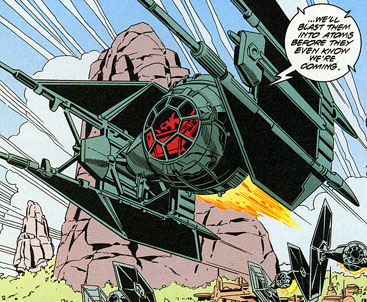
TIE Advanced X1
Lord Vader's personal fighter belonged to this class of long-range (hyperdrive-capable) fighters. It is sometimes regarded as a custom or deluxe design, but this may be just a figment of hindsight, since this class became a source of inspiration for the later, famous Interceptor and Avenger models. This heavy fighter may actually have been a commonplace long-range fighter design used throughout much of the history of the Empire: according to blueprints, the star destroyer Imperator (the first of its class) originally carried a number of unipod bent-wing "TIE assault craft".
The "customisation" of Vader's personal TIE might actually extend no further than its provision of shields (This is a distinctive feature; most TIE fighters are unshielded and rely on superior piloting skill and tactical advantage.) Alternatively, the modification might involve the partial removal of shields or targeting systems, since Vader's excellent piloting skills are augmented by his mastery of the Force. Perhaps the speed or the power of the weapons have been enhanced. Perhaps the customisation involves life-support in the cockpit; Vader's fighter might optionally provide him with an environment similar to that created in his hyperbaric meditation chambers.
In any case, this fighter is significantly faster and more manoeuvrable than its mass would suggest. Four thruster nozzles are placed in two pairs above and below the extended tail of the fighter. This section, containing a shield and hyperdrive units, blocks the usual cockpit rear viewport. Therefore a realistic holographic viewscreen is mounted behind pilot seat to mimic the rear window found in ordinary TIE starfighters. Judging by cockpit interior details, the main hatch is still at the rear of the ship, but the mechanism by which it opens must be more complex than for TIEs with a simple unadorned hull pod.
The wing pylons are thicker than usual, and there are large holes in their front faces. Through these gaps, a set of curved pipes can be seen. The pipes run in the same general direction, from the main hull towards the wings. These probably carry outbound coolant. The partial exposure of these pylon pipes to space may be a modification to further improve the removal of excess heat. The long-range TIE Scout craft described above also has thick pylons with similar holes.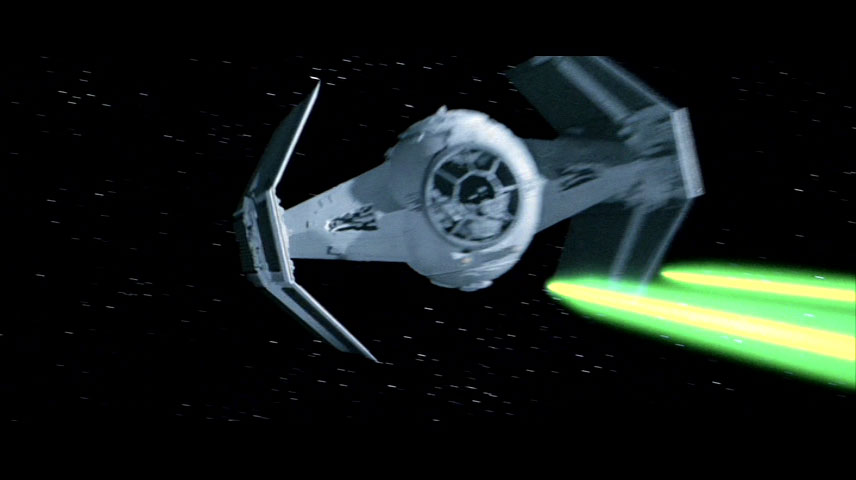
-
the X-wing is supposed to be one of the fastest vehcle right?
the millenium falcon is oso damn fast -
TIE [X1 relative]
The computer game X-Wing includes a fighter that appears to be related to Lord Vader's X1. The wings are the same as on the X1, but the hull and pylons are the those of a plain short-range TIE fighter, without the trailing fin. It is shielded and has two laser cannons but no hyperdrive. In game terms, it appears in several missions, including one against the Death Star. About forty of these fighters were seen in the missions. In intra-textual terms, it may be a shorter-range descendent of Lord Vader's model, perhaps being called the X2. It is seen in association with the Death Star, and may have been a rare, exclusive production.
The game performance statistics are the same as the TIE Avenger, except for the missile weapons and hyperdrive. Strangely, it is replaced by Avengers in the Collector's CD-ROM edition of X-Wing. This is a discontinuity because the Avenger was only developed much later in the STAR WARS chronology, in the TIE Fighter game, which occurs after TESB.
Dorsal views of the thin-pylon, bent-wing TIEs of Omega Squadron in the X-Wing game. The dorsal view clearly shows that the tail fin of the TIE X1 is absent.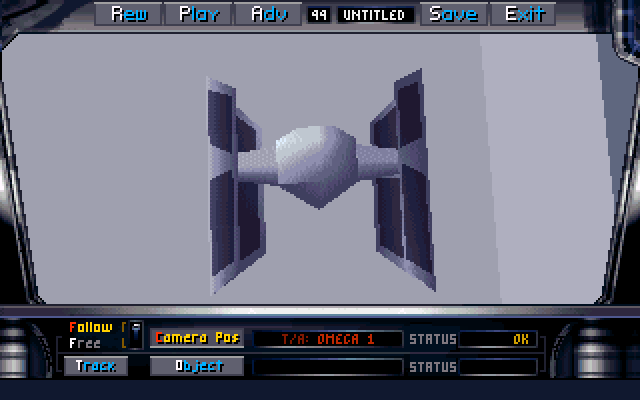
TIE Avenger
Another distinct fighter, with greatly enhanced and overpowered weaponry, was used at least as early as a few months after the Battle of Endor. This ship had four cannons of enormous size on the wingtips, and one cannon of more ordinary magnitude on each wing hub. There are no weapons on the chin of the cockpit ball.
The observed example was flown by one Major Grode, of His Majesty's Crimson Squadron, stationed at an Army garrison on Cilpar. The garrison was in disarray and had suffered from the continual attrition wrought by a local resistance movement. Grode had obvious problems with equipment and personnel. This may be the reason why he was the only member of his unit to possess the elite fighter: it may be the only operable one left; or he may have simply scrounged it. Since the Imperial forces remaining on Cilpar were particularly decadent, it can be assumed that this design predates the Emperor's fall and was not particularly rare.
TIE Defender
The most advanced combat TIE seen so far. Developed shortly after the Battle of Hoth, following the success of the TIE Avenger. Its applications were similar to those of the Avenger: campaigns of vital importance to the Emperor, especially the efforts against pre-Endor warlordism within the Imperial Forces. Equipped with hyperdrive, deflector shields, and advanced weaponry of various kinds. It is the fastest and most manoeuvrable manned spacecraft known, but production was limited by its enormous cost: over 300000 credits each. The Defender was only available to the most elite starfighter units with proven performance on the Avenger.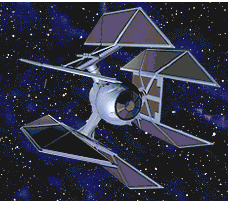
-
actually, no. lots of TIEs are much faster. and many later New Republic fighter models were faster as well.Originally posted by dumbdumb!:the X-wing is supposed to be one of the fastest vehcle right?
the millenium falcon is oso damn fast -
TIE Scimitar
When Grand Admiral Thrawn returned from his missions on the galactic fringes to wage a campaign against the New Republic, the TIE Scimitar was developed and commissioned on his orders. This heavy bomber design also seems to have reached the forces of the Palpatine Clones on Byss. [The fugitive Royal Guardsman Kir Kanos possessed a TIE Scimitar in Crimson Empire.]
The hull is an elongated unipod design, with the cockpit extending forward beyond the wings to provide superior crew visibility. The two crewmen enjoy extensive viewport strips along the cockpit ceiling, and below to port and starboard. In an emergency, the entire cockpit pod can detach to jettison the wings, main hull and payload.
A TIE Scimitar is propelled by a single ion engine, augmented by a pair of powerful manoeuvring repulsor drives mounted on the wings. Repulsors are the most efficient form of propulsion within the gravity well of a significant planetary body; and bombers naturally spend many missions attacking ground targets.
The wings are an unusual shape: scalloped so that the panels turn back slightly around the pylon. This increases the craft's forward or rear profile, and hence its vulnerability to enemy fire. The explanation for this design compromise is not obvious. It may be less a concern for this bomber than other TIE designs, since the Scimitar is equipped with strong shield generators. It may be an aerodynamic concession of some kind, owing to the fact that these bombers often operate in atmosphere; or it may have something to do with leverage and the action of the repulsors to turn the craft.
TIE Drone
This is a droid/computer controlled starfighter mass-produced from the factories of the World Devastators of the Battle of Calamari and the Shadow Hand campaign. The vehicle is often called a "TIE Droid", although it would be more specific and appropriate to call it a TIE drone instead, since a "drone" is literally a starfighter with artificial intelligence whereas "droid" usually refers to an independent ambulatory android that could be separated from a vehicle. SFS had experimented with drone TIEs for many years, but they were impractical as long as the Empire dominated the sapient and material resources of the galaxy. The drone fighter's programmed piloting and combat tactics tend to be idiosyncratic or inferior to a living pilot. Therefore the ability to mass-produce it is the only major advantage. The TIE drones are deployed only in overwhelming numbers, and in situations when the efficiency of manufacturing outperforms the effectiveness of Imperial pilot recruitment and training.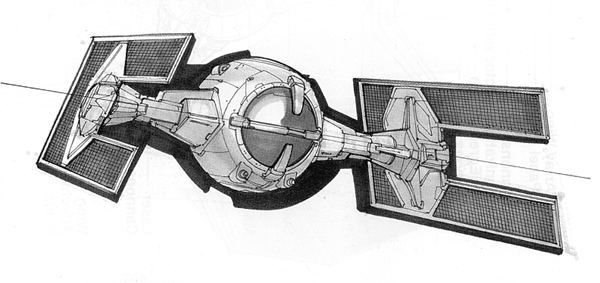
TIE Phantom/TIE [V38] (Sentinel?)
A fighter design which apparently was well-known in the STAR WARS universe but thusfar has only been glimpsed in the literature in the form of a modified cloaked variant. At this time we have no way of knowing which of the Phantom's features are shared by the parent model. The basic hull, engine and wing configurations are probably the same; if there were fundamental changes then Ackbar would not be justified in calling the cloaked ship a mere modification. The cockpit is certainly a standard TIE ball, attached to the main hull, rather than the makeshift conical alternative used on the transitional Phantom.
The military and colloquial names for this fighter have not yet been revealed. The technical designation used by Admiral Ackbar is V38. Perhaps it would be listed as TIE/V on tactical displays (with this ship being the 38th sub-model), and the common name (analogous to "Interceptor" or "Defender") beginning with a "V". Alternatively, it may be the "TIE Sentinel" mentioned in the Hasbro online survey; this designation fits the V38 better than its cloakable descendent. Of course these speculations may actually be meaningless, since the Galactic Empire does not use the Latin alphabet and all fighter designations are translations from Imperial Basic.
The three wingtip cannons on the TIE Phantom may be a hint at the role of the mainstream TIE Sentinel production model. If these weapons are ion cannons they would compliment the laser cannons on the cockpit chin, and also would help to round out regular TIE starfighter forces, which generally lack ion cannons. The absence of ion cannons on common TIEs may have a tactical reason, or else it due to technical constraints (eg. ion cannons may require power systems that are not easily contained on compact starfighters). The TIE Sentinel is not a rare vessel, but not a dominant and common design either. Its tactical role must be special in some way, and the ion cannon hypothesis seems a good possiblity (though not a unique solution).
(TIE Phantom)
This is a little-known experimental two-man fighter produced in limited quantities at a secret facility sometime before the Battle of Endor. According to Admiral Ackbar, it is a modified version of an extant fighter model called V38, with the most important addition being a special set of sensor/scanner countermeasures.
In the computer game the prototype craft appeared to be named "Phantom", but the term "TIE Sentinel" has also appeared (most prominently in a Hasbro online survey about future toy concepts). Most likely a TIE Sentinel is the V38, lacking a cloaking device, and the cloakable experimental fighter is the TIE Phantom.
The triple wings total a radiator area equivalent to over double that of a TIE interceptor. There are three engine outlets in an equilateral triangular configuration on the stern, which is a flat rather than spherical surface.
The cockpit configuration is unusual; it looks more like part of a Corellian freighter than a spherical Sienar design. This may have been used only on prototypes; production models, had they ever been built, probably would followed SFS conventions. Crew enter through an elevator hatch under the primary hull.
The vessel is armed with two chin-mounted laser cannons in addition to the three which appear to be mounted on the wingtips. It also carries some remarkable power-consuming extras, which might reduce its propulsive performance to something less than an older fighter or bomber. These luxury devices including a shield generator, a hyperdrive, and some sort of cloaking device which is capable of operating even during a hyperjump.
The latter feature is most surprising for a ship of this size. The Imperial Navy only used cloaking devices for very special tactical purposes, and full cloaking shields were technically impractical on anything but large warships or cargo vessels. A cloaking device mounted on a starfighter must have some drastic hidden or overt drawbacks. Perhaps there are dangerous side-effects for the pilot? Perhaps the fighter contains a compact but unstable energy source that produces a gargantuan explosion when the ship is crippled? In any case, the cloaking devices on the prototypes were flawed, the cloak effect tended to flicker on and off, and was prone to outright failure.
-
A-wing? Y-wing?
And then theres this ship that is supposed to be indestructible... My friend who is a star wars fan told me its in one of those books, approved by lucas, that details the stories after the return of the Jedi??